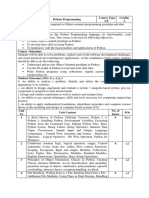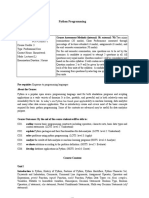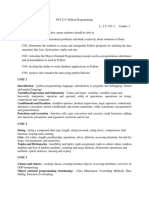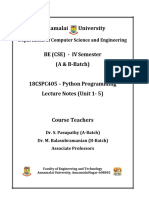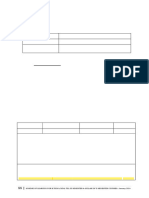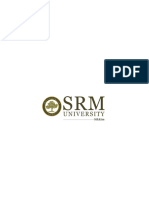BCA_3rd Sem_TBC304_Python Programming_Punitha_updated
Uploaded by
vanshikavanshika920BCA_3rd Sem_TBC304_Python Programming_Punitha_updated
Uploaded by
vanshikavanshika920TBC304 - Python Programming
Program Bachelor of Computer Applications
Semester 3
Course Title Python Programming
Course Code TBC304
Course Credits 3
Course Type Core Theory Course
1. Course Summary
The aim of this course is to help students learn about data types, expressions and control
structures, progressing to advanced topics such as text manipulation, data encryption and
working with files, lists and dictionaries. The course delves into functions, classes and object-
oriented programming, teaching students to create reusable code and manage complex
programs. It also covers the creation of Graphical User Interfaces (GUIs) and explores event-
driven programming. Students can learn about multithreading, network programming and
client/server applications. By the end of the course, students are equipped with the skills to
apply Python in a wide range of real-world scenarios, from simple scripts to complex
applications.
2. Course Outcomes (COs)
After the successful completion of this course, the student will be able to:
CO-1. Understand and apply the basic programming constructs of Python suitably. [L-1]
CO-2. Explain the concepts of string processing, file I/O, lists and dictionary. [L-2]
CO-3. Explore reusability and the object-oriented principles for modeling and developing.
[L-3]
CO-4. Construct applications with graphical user interface. [L-5]
CO-5. Develop software solutions using multi-threading, networking and client-server
concepts. [L-6]
3. Course Contents
Sr. Number
Units
No of Hours
UNIT- I
Python Overview, Data Types, Expressions and Control Flow: Python
interpreter and interactive mode. Debugging. Assignment and Comments.
1 Numeric Data Types and Character Sets. Expressions. 9
Conditionals: Boolean values and operators. conditional (if). alternative (if-
else). chained conditional (if-elif-else). Iteration: while, for, break, continue,
pass.
2 UNIT- II 9
23OBC304 Python Programming Page 13
Strings, Lists, Tuples, Dictionaries and Files:
Strings: String slices. Immutability. String functions and methods. String
module.
Lists: List operations. List slices. List methods. List loop. Mutability. Aliasing.
Cloning lists. List parameters.
Tuples: Tuple assignment. Tuple as return value.
Dictionaries: Operations and methods.
Files: Text files. Reading and Writing files text files. format operator.
UNIT- III
Functions and Classes: Functions as abstraction mechanisms. Problem solving
with Top-Down design. Design with Recursive functions. Managing a program’s
3 namespace. Higher order functions. Objects and classes. Data modelling 9
Rational numbers. Arithmetic and operator overloading. Comparison methods.
Using pickle for permanent storage of objects. Input of objects and try-except
statement. Structuring classes with Inheritance and Polymorphism.
UNIT- IV
Graphical User Interfaces: GUI-Based Programs. Terminal-Based Version. GUI-
4 Based Version and Event-Driven Programming. Windows and Labels. Displaying 9
Images. Command Buttons and Responding to Events and Viewing the Images.
Entry Fields for the Input and Output of Text. Using Pop-up Dialog Boxes and
Other Useful GUI Resources.
UNIT- V
Multithreading, Networks, And Client/Server Programming:
Multithreading: Threads and Processes. Threads. Sleeping Threads. Producer,
5 9
Consumer and Synchronization.
Networks: Basic definitions of Clients and Servers, IP Addresses, Ports, Sockets.
Client/Server Programming: A Day/Time Client Script. A Day/Time Server
Script. A Two-Way Chat Script.
3. Course Resources
a. Essential Reading
1. Course Self-Learning Material
2. Kenneth A. Lambert, Martin Osborne, “Fundamentals of Python: First
Programs, Cengage Learning”, CENGAGE Learning, Second edition, 2018,
ISBN 13:978-1337560092.
3. Michal Jaworski, TarekZiade, “Expert Python Programming”, Packt
Publishing, Second Revised edition, 2016, ISBN-13: 978-1785886850.
b. Recommended Reading
1. Rick van Hattem, “Mastering Python”, Packt Publishing, Second Edition,
2016, ISBN 139781786463746.
23OBC304 Python Programming Page 14
2. 2. Zed A. Shaw, “Learn Python the Hard Way”, Addison-Wesley, Third
Edition, 2014, ISBN13: 978-0-321-88491-6. Ananda Kumar, A., 2009,
Switching Theory and Logic Design, Prentice Hall of India.
3. Kent D Lee, “Python Programming Fundamentals”, Springer-Verlag London
Limited, 2011, ISBN 978-1-84996-536-1.
23OBC304 Python Programming Page 15
You might also like
- bca syllabus 2024 - 2025 FINAL I YEAR (1)No ratings yetbca syllabus 2024 - 2025 FINAL I YEAR (1)13 pages
- Course Code CSE3011 Python Programming Course Type LP Credits 3No ratings yetCourse Code CSE3011 Python Programming Course Type LP Credits 33 pages
- Mca2022 - Advanced Python-Programming - (Elective)No ratings yetMca2022 - Advanced Python-Programming - (Elective)2 pages
- Introduction To Python Programming - Theory100% (1)Introduction To Python Programming - Theory3 pages
- Detailed Syllabus of Ii Semester Core Courses:: A. Overview of The CourseNo ratings yetDetailed Syllabus of Ii Semester Core Courses:: A. Overview of The Course4 pages
- DS225_Industry Coding Practice(Python and R)_Sangeeta.docxNo ratings yetDS225_Industry Coding Practice(Python and R)_Sangeeta.docx5 pages
- It454: Python Programming CREDITS 6 (L 4, T 0, P 2)No ratings yetIt454: Python Programming CREDITS 6 (L 4, T 0, P 2)2 pages
- HOT Python Programming Curriculum - 04032024No ratings yetHOT Python Programming Curriculum - 040320243 pages
- 3-Year Under Graduate Programme in Mathematics Revamped Curriculum Design and Model SyllabusNo ratings yet3-Year Under Graduate Programme in Mathematics Revamped Curriculum Design and Model Syllabus2 pages
- 19cs301problem Solving and Python ProgrammingNo ratings yet19cs301problem Solving and Python Programming3 pages
- CS 201 Introduction To Programming With Python:: Aaleksan@bu - EduNo ratings yetCS 201 Introduction To Programming With Python:: Aaleksan@bu - Edu3 pages
- HOT-Python-Programming-Curriculum_11052022-1No ratings yetHOT-Python-Programming-Curriculum_11052022-13 pages
- Second Semester B.tech. CSE- AIML, ECE and ICTNo ratings yetSecond Semester B.tech. CSE- AIML, ECE and ICT18 pages
- INFT 625 - Course Outline - Programming For Data Science Fall 2023No ratings yetINFT 625 - Course Outline - Programming For Data Science Fall 20234 pages
- Python Programming - Theory - 1010206302No ratings yetPython Programming - Theory - 10102063023 pages
- Mastering Python Programming: A Comprehensive Guide: The IT CollectionFrom EverandMastering Python Programming: A Comprehensive Guide: The IT Collection5/5 (1)
- Tensioners Warper: General SpecificationsNo ratings yetTensioners Warper: General Specifications2 pages
- The Role of Nursing Informatics On Promoting Quality of Health Care and The Need For Appropriate EducationNo ratings yetThe Role of Nursing Informatics On Promoting Quality of Health Care and The Need For Appropriate Education7 pages
- Qualys Virtual Scanner Appliance User GuideNo ratings yetQualys Virtual Scanner Appliance User Guide19 pages
- Learn How To Program The Easy and Fun WayNo ratings yetLearn How To Program The Easy and Fun Way148 pages
- COMP313 W1 - Computer Systems Test 3 Networking Total Marks: 30No ratings yetCOMP313 W1 - Computer Systems Test 3 Networking Total Marks: 303 pages
- Frost Radar™ - Global SD-WAN Vendor Market, 2021No ratings yetFrost Radar™ - Global SD-WAN Vendor Market, 202128 pages
- Analogue and Digital Electronics: FilterNo ratings yetAnalogue and Digital Electronics: Filter15 pages
- Industry Oriented Software and Hardware Training For Biomedical - 2015No ratings yetIndustry Oriented Software and Hardware Training For Biomedical - 20151 page
- B650D4U Server - Workstation Motherboard Manual - ASRock RackNo ratings yetB650D4U Server - Workstation Motherboard Manual - ASRock Rack100 pages
- CSE 238/2038/2138 Systems Programming Project 1 Binary Data Converter Due: 02.12.2020 11:59PMNo ratings yetCSE 238/2038/2138 Systems Programming Project 1 Binary Data Converter Due: 02.12.2020 11:59PM3 pages
- [FREE PDF sample] Multicore and GPU Programming An Integrated Approach 2nd Edition Gerassimos Barlas ebooks100% (4)[FREE PDF sample] Multicore and GPU Programming An Integrated Approach 2nd Edition Gerassimos Barlas ebooks40 pages
- FlashSystem Overview and Safeguarded Copy Level 2 Quiz - Attempt Review - ElNo ratings yetFlashSystem Overview and Safeguarded Copy Level 2 Quiz - Attempt Review - El13 pages
- Lecture 9 ESO207 AbstractDataTypeListImplementationNo ratings yetLecture 9 ESO207 AbstractDataTypeListImplementation26 pages













